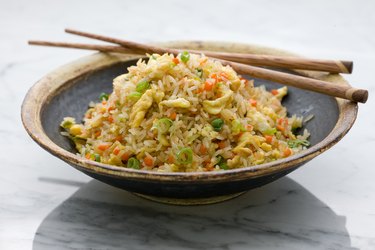
Fried rice is a popular entree at Chinese and other Asian restaurants. Most of the calories in fried rice come from carbohydrates and because it's usually fried in oil, it also has a bit of fat. This leaves some wondering whether or not fried rice is healthy.
But as it is with most foods, the nutrition in fried rice really depends on exactly what's in it. Adding meat like chicken or shrimp to fried rice ups the calories, protein and fat. You can have more control over the nutrition and calories in fried rice by learning to make it at home.
Video of the Day
Video of the Day
Fried Rice Calories and Nutrition (Per Cup)
Calories | Carbs | Fat | Protein | |
|---|---|---|---|---|
Restaurant Chinese fried rice (without meat) | 238 | 45 g | 4.1 g | 6 g |
293 | 60 g | 3 g | 8 g | |
338 | 57 g | 5.4 g | 13 g | |
241 | 45 g | 1.3 g | 9 g | |
352 | 55 g | 8 g | 16 g |
Fried Rice Nutrition
The nutrition in your fried rice will depend on the ingredients in it. Sodium and fat, in particular, can vary widely in fried rice recipes, especially if you're buying it from a restaurant.
According to the USDA, a cup of restaurant Chinese fried rice without meat has about:
- Calories: 238
- Total fat: 4 g
- Saturated fat: 1 g
- Trans fat: 0 g
- Cholesterol: 25 mg
- Sodium: 530 mg
- Total carbs: 45 g
- Dietary fiber: 2 g
- Sugar: 0 g
- Protein: 6 g
Calories and Macros
Fried rice without meat from a Chinese restaurant has about 238 calories per 1-cup serving, and adding meat such as chicken, shrimp or beef can add anywhere between 15 to 120 additional calories, per the USDA.
Most of the calories in fried rice come from carbs, and you'll get 45 grams per serving. That's 15 percent of your recommended daily value (DV).
You'll also get 4 grams of fat, which is about 5 percent of your DV. The kind of oil that's used to cook the fried rice will determine the specific amounts of saturated, polyunsaturated and monounsaturated fats.
Plain fried rice without meat has about 6 grams of protein per serving, and adding meat ups that to anywhere between 8 and 16 grams. Chicken and beef fried rice have the most protein (but beef fried rice also has the most fat).
The amount of protein you need in your diet is determined by your age and activity level. Adults and teens need between 45 and 55 grams of protein per day, per the Harvard School of Public Health.
Sodium
Fried rice can be high in sodium. While sodium is a necessary nutrient, you should aim to take in less than 2,300 milligrams per day, or ideally, around 1,500 per day (which is linked to a lower heart disease risk, according to the American Heart Association.
Fiber
Generally, white rice is used to prepare fried rice, which makes it low in fiber. Half of the grains you eat per day should come from whole grains, such as brown rice, because they add fiber to your diet.
Fiber is an important nutrient for heart and gut health, so if you're eating fried rice from a restaurant, make sure to fill your diet with whole grains the rest of the day.
Is Fried Rice Healthy?
Fried rice prepared in a restaurant may be higher in sodium, fat and calories, but in moderation, it can fit into a healthy diet.
You can make fried rice healthy by making your own at home. Try loading it up with vegetables which will add vitamins, minerals and nutrients like fiber. Keep the sodium low by adding very little salt or soy sauce, or using a low-sodium sauce to prepare it. You can also choose to use brown rice instead, which will bump the fiber up significantly.
- USDA Nutrient Database: "Rice, fried, with chicken"
- Healthy Weight Forum: "How Many Calories in Chinese Food?"
- Harvard School of Public Health: "How much protein do you need every day?"
- USDA MyFoodData: Vegetable Fried Rice
- USDA MyFoodData: Restaurant Chinese Fried Rice (No Meat)
- USDA Food Data Central: Fried Rice, Beef added
- American Heart Association: How Much Sodium Should I Eat Per Day?
- Food and Drug Administration: "Trans Fat"